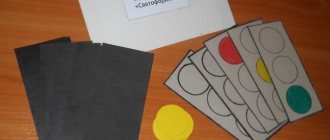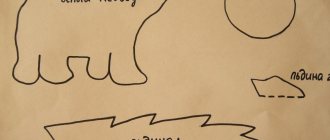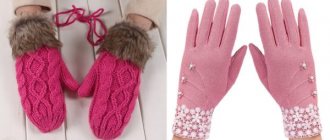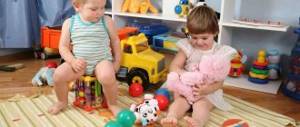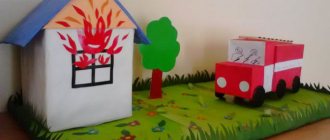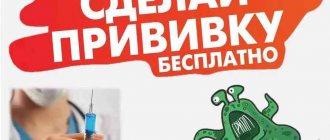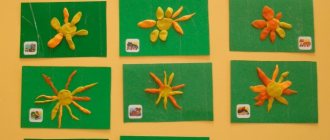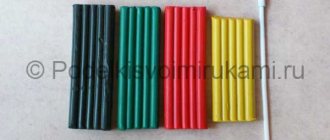Applique templates made from colored paper car truck for children
Educational environment is a set of conditions purposefully created in order to ensure the full education and development of children. Developing subject-spatial environment &nd...
Each preschool teacher will tell you the importance of the application for the upbringing and all-round development of a child. In any aspect, be it mental, moral, labor, sensory or aesthetic education, appliqué plays an important role.
Educator: We take the scissors in our right hand in front of us, and our left hand turns the paper in the desired direction. We work carefully. An easy and relaxed manner is the best way to convey the topic of “safety” to children from various perspectives.
Lesson summary for the senior group application “Cars are driving along our street.”
In accordance with the Federal State Educational Standard for preschool education, psychological and pedagogical work is carried out in the following educational areas: social and communicative...
Preschoolers explore the properties of various materials used to create works, gain knowledge about the compatibility of colors and textures, have the opportunity to move cut out shapes, compare them, superimposing one on top of another.
But it is necessary to remind you of safety rules before work, as well as keep all children in sight.
This will help you learn the colors and rules of the road and the kids will love it. The applique is also suitable for making in the middle group.
On the topic: methodological developments, presentations and notes
Goal: To develop children's cognitive interest in the world around them. Objectives: Educational: - consolidate the ability to classify types of transport - improve dialogic speech - consolidate sound skills...
She came to you with a very big request. Little Red Riding Hood asks you to make cars from the applique so that she can drive them every weekend to visit her grandmother. Guys, let's help Little Red Riding Hood, but before we start making cars, we need to consider her.
It is useful to organize reading stories and poems about transport and architecture, guessing riddles, you can conduct a thematic mini-quiz “Do I know the streets of my city?”, role-playing games using building materials and toy vehicles.
How will we spread the glue? That's right, from the middle to the edge. Now you get to work, and Little Red Riding Hood will watch you.
The many different forms allow children to become familiar with many examples of traffic rules, both for pedestrians and as passengers in vehicles.
Higher pedagogical education, specialty: history and law, postgraduate study. Work experience in higher education - 22 years. The scope of professional activity is conducting lectures and seminars, educational, methodological and scientific work (there are scientific publications).
It is no secret that to successfully conduct classes in preschool educational institutions with children of any age, systematic and targeted preliminary work is necessary.
Higher pedagogical education, specialty: history and law, postgraduate study. Work experience in higher education - 22 years. The scope of professional activity is conducting lectures and seminars, educational, methodological and scientific work (there are scientific publications).
When planning a lesson on the topic “Houses and cars on our street,” the teacher organizes targeted walks along the city streets, where children observe transport, buildings, green spaces or snow cover (depending on the time of year), and pedestrians.
Large colorful samples of various machines are used to create applications by children in kindergarten. They develop cognitive interests and the ability to observe, peer into an image, and notice interesting details.
Wall newspaper
This is an incomparable visual aid. It is issued together with children at school by the teacher who supervises work on traffic rules. To keep information up to date, it is recommended to release it once every two weeks. Here you can create various sections, reflecting information about traffic rules competitions and the work of the team of Young Traffic Inspectors. You can place a certain historical educational program on traffic rules.
The history of flicker, traffic lights and road signs will certainly attract the attention of many. Young intellectuals may be interested in a crossword puzzle or a chain word on traffic rules. Photos of non-standard road signs from other countries will inspire you to become more familiar with your own. The main thing is to involve children in learning and observing the Rules of the Road. And for this, all means are good!
Master class on making wall newspapers. It can be stationary with changing sections or completely changing. Let's consider the stationary option.
The format A 1-Whatman paper is best used for wall newspapers. 1. We measure its dimensions. 2. A sheet of plywood is taken and processed in such a way as to create a stand with the specified parameters. 3. Take whatman paper and mark the place for the main heading and headings. 4. We design the wall newspaper according to the developed plan. 5. Using a screwdriver, attach the brackets on which the stand will hang to the plywood. 6. Take the buttons and attach the wall newspaper to the stand. All is ready!
Such a wall newspaper can always be easily updated. And if it is published on a schedule by a changing editorial board, then readers will never get tired of it with its sameness. And if you hold a competition of similar wall newspapers between classes at school, then the work on studying traffic rules will be in full swing all year, which will affect the reduction in accident rates. After all, where traffic rules are taught in this way, children get into fewer accidents! Making traffic lights, signs, and wall newspapers can be combined with learning poems, songs, reading stories, and watching cartoons on traffic rules. This way information is remembered much faster and better.
Features of conducting appliqué classes in the senior group
Educator: What wonderful, beautiful buses we got. What did we do today? Who did they help? What great fellows you all are! The bunny thanks you for your help! Now he will quickly get home to his mother.
A beautifully designed activity! Thank you! Children consolidated their knowledge about transport through interesting poems and riddles. And the children's work is simply wonderful.
Summary of a lesson on teaching traffic rules “Our friend the traffic light” (middle group) Objectives: Educational: to introduce children to the rules of behavior on the road, with the concepts of “pedestrian crossing”, “traffic light”. Clarify ideas.
Summary of the direct educational activity “Volnushki and foxes are traveling on the train” on construction, speech development, and familiarization.
Summary of direct educational activities on artistic creativity (applications) on the topic: “Spider”. Goals: Teach children to work.
In the older group, one of the most productive ways to motivate children to apply on the topic “Home” is accompanied by visuals, that is, pictures, posters, and an educational conversation. For example, that not all people live in the same high-rise buildings or mansions as we do.
Guys, I take the scissors in my hand. How should I hold them in my hands? That's right, my thumb is in one ring, my middle finger is in the other, and I hold the bottom with my index finger.
Strengthen the ability to work with paper and glue, create a holistic composition from elements. Develop fine motor skills.
Technique: symmetrical and tape (sheet folded like an accordion) cutting. Children realize the compositional idea independently, and also cope with cutting out parts on their own.
Rectangles and squares of colored paper for cutting machines, felt-tip pens, colored and simple pencils, scissors, glue, glue brushes, oilcloths, paper and cloth napkins, an unfinished overall composition “Our City”. Silhouettes of cars for showing to children (buses, trolleybuses, trams, cars).
Despite the fact that children daily participate in traffic together with adults (crossing the road or riding in vehicles), the topic of traffic rules is unfamiliar to them and they are the most vulnerable part of the population to road accidents.
The teacher alternately closes the halves of the car silhouettes (first on the right, then on the left). He asks what feature the children noticed in the structure of these machines.
Progress of activities
Children, this morning I found a small ticket on the window. It turns out that an exotic animal circus has come to our city of Tyumen. And this ticket invites us to the show. How can you go to the circus? (by car, by taxi, by minibus, by bus
)
.
Guess the riddle: What a miracle - a long house!
There are a lot of passengers in it.
Wears rubber shoes
And runs on gasoline ( bus
)
.
Considering a toy bus
.
the bus
have (body, windows, wheels)
.
Guys, look how many of us there are. We can't all fit on one bus
.
What to do? (make another
bus )
. First, I will complete the main part - the body, smoothly cutting off 2 corners along the upper side of the rectangle. What's missing (no windows or wheels)
.
Now I'll make the windows. I take a white strip, fold it in half, then in half again. I unfold it and cut it into pieces along the folds. Like this: this is one window, this is another, and here is the third and fourth. There are only four windows. I lay out the windows on the bus - just like that
, carefully and glue them one by one.
What else is missing? (wheels)
.
I take a black square and cut off the corners to make a circle. I glue the wheels onto the body of the bus
.
Installation for work.
Let's remember the safety rules for using scissors: Scissors should not be left open; Do not hold the blades up or towards you, as you may stumble and get hurt.
I remind you that before applying glue to the part, the applique
First place it on the sheet, and then just glue it.
To make the bus beautiful
. The wheels are glued last.
For those children who quickly make the applique
, offer to decorate
the bus
. Ensure careful handling of paper and glue; watch your posture.
Physical exercise. (Game " Bus
»
) movement through the text.
We are sitting on the bus
, and we look out the window.
We look back, we look forward, well, the bus is not lucky
.
The wheels started spinning, we rolled forward,
And the brushes rustle on the glass
Let the bus shake us
, we are moving, we are moving forward.
Guys, look how many buses
. They are all beautiful and bright. Now there is enough space for everyone. Let's invite parents and friends to go to the circus with us.
Publications on the topic:
“Peace is the main word in the world...” Synopsis of GCD in the middle group of kindergarten on application. Goal: To develop creative abilities.
Lesson notes on the application “Bus for Friends” (second junior group) Application. 2 ml. gr. Topic: Car fleet: plot “Bus for friends” Objectives: 1. Continue teaching children to modify the shape of objects. 2. Encourage.
At the beginning of February, our group began to prepare for the celebration of Defender of the Fatherland Day. We learned poems and patriotic songs, studied various ones.
Summary of GCD in the middle group of kindergarten Summary of integrated GCD in the middle group topic: “Rays for the Sun” Compiled by senior teacher: Zamoshnikova I.V. Objectives: Develop.
Summary of GCD in the middle group Theme “Dymkovo toy”. Educational area: NGO “Artistic and Aesthetic Development” NGO “Cognitive.
Summary of an open lesson on applique in the middle group of the kindergarten “The Sun Woke Up” Goals: making applique from pasta. To support in children the desire to complete the work they have started, following the motivation of the game.
Application is an amazing world of discovery and fantasy, which all children love to travel through. Let's look at how you can make a bus applique craft. When performing various creations, you will need the following tools and materials: PVA glue, brush, glue stick, ruler, simple pencil, sharp scissors, felt-tip pens or markers, white and colored paper, double-sided colored, white and colored cardboard.
We can also use various available materials. For example, wheels can be made from buttons, windows and headlights can be cut out of thick fabric, and felt can be used for the body.
Organization of the lesson: structure, motivating beginning, notes
House appliqués are made both from paper, that is, using classical techniques, and from straw and fabric, that is, using non-traditional techniques.
Teach children to convey the shape and relative positions of parts of different machines. Strengthen a variety of cutting techniques in a straight line, in a circle; neat gluing techniques.
To diversify your work and get a craft like in the photo, create a frame from leftover colored paper. To do this, bend it in half and glue a few more hearts. Please note that in accordance with Federal Law N 273-FZ “On Education in the Russian Federation”, organizations engaged in educational activities organize the training and education of students with disabilities, both together with other students and in separate classes or groups.
The teacher shows the children several toy cars and asks questions about their appearance: what is common and how do the cars differ from each other?
Take strips of blue paper, fold in half, in half again, draw the folds, now unfold. How many parts did you get? What shape? Now cut along the fold lines. We got windows. We stick them on houses. We make sure that the windows are level.
Summary of direct educational activities in the older group of children with mental retardation. APPLICATION “On the street of our car, car.” Target. Development.
Planning lessons
In the senior group, standard long-term planning provides for one application lesson per week. The total duration of continuous activity should not exceed 20–25 minutes; methodological manuals recommend performing physical exercises (finger, breathing, motor exercises) for 5 minutes for relaxation and prevention of mental and physical fatigue in children.
Lesson outline:
- Introductory part - includes an educational or playful conversation of a motivating nature, stimulating the activity of children and setting them up for working with a specific plot (approximately 3-5 minutes).
- Practical part - the teacher explains and shows the sequence and technical techniques of work, draws children's attention to the need to be careful when working with scissors, and to use glue carefully (3-5 minutes).
- Independent work of children (15–20 minutes);
- The final part - children review and discuss the applications they have created or team work (3 minutes).
It makes sense to start a conversation of a developing and educational nature with questions about street names, transport, you can take a short interesting excursion into the historical past of the city, remember the sights and monuments that are the calling card, the symbol of your hometown. The lesson will be interesting if the teacher thinks through the game line of the scenario, taking as a basis one of the popular fairy tale plots: the poetic fairy tale “Cat’s House”, the adventures of the three little pigs, Uncle Pumpkin’s dream of a house from Gianni Rodari’s literary fairy tale about Cippolino, a touching story about the liberation of his hometown from the invaders from the play by T.G. Gabbe “City of Masters”, etc.
Poems and riddles that can be used in lessons about home or city topics.
| I'll build myself house , There will be a lot of space in it! There will be a table and a stove in the house. I will let a sheep into my house. I’ll let the cockerel into my house, and the chicken with him. And a cow, and kids, and horses - and a pig. A dog and a cat - of course, they have more fun with me. I need the goose for order. Those who are naughty will pinch the heel. The owl will live with us - To guard the house at night... But I began to doubt something: Will mom and dad agree? (I. Stolova) I built a house , A small house, so that a mouse could live in it and not go into the hole. But a snail came, stole the house and lives in the house, instead of a mouse. (K. Melnikova) | Here is a square, a triangle, it turned out whole house ! We'll put a cat in it, so he'll have fun! Here is a flower on the windowsill, a tea table on the balcony. Next to the house is a garage, a booth and our dog. I saw an amazing house , A funny, friendly gnome lives in it. The walls are made of waffles and the roof is covered in fondant - a wonderful shade, and the door is a chocolate bar. Porch steps - Fragrant iris, Heart-shaped windows - Beautiful, pleasant. In the garden near the house there are bushes of marmalade, dewdrops of rum, a fountain of lemonade. I really liked the fairy-tale house. What a pity that I’m taller than a gnome. (N. Shichaev) | Mushrooms have been born with one sprout, they stand along the path, their backs are straight, the old mushroom breaks, a new one grows. (Street with houses) My relatives live in it, I can’t live a day without them. I strive for it always and everywhere, I will not forget the road to it. I can hardly breathe without him, My home, dear, is warm. (House) What is on my house And most important and above all? Without which a house is not a home (Roof) They stand on the street all day, smiling at passers-by. Their service begins when it is already dark. (Lights on the street) I’ll let you into anyone’s house. If you knock, I’m glad to hear the knock. But I won’t forgive one thing - If you don’t give me your hand. (Door) |
In the lesson scenario, the teacher indicates goals and objectives. In the process of planning, organizing and conducting applique classes with older preschoolers, they usually focus on solving the following problems:
- Learning to design from pieces of cotton wool, fabric, leaves on a cardboard or paper base, using plasticine, further improving the ability to work with scissors, glue and colored paper.
- Development of independence and creative initiative in determining the plot or genre (object painting, landscape) of the application.
- Developing the ability to hear and understand musical or poetic accompaniment that sounds during the performance of a creative task. Such an interesting combination of various methods of emotional and artistic instruments of influence is aimed at achieving the comprehensive aesthetic development of children, the formation of artistic taste and a sense of beauty.
Lesson summary on application on the topic “City of Friendship” (author L. Timofeeva)
Tasks:
- teach students to cut out several identical parts from a strip folded like an accordion (windows of a house, wheels for cars, strips for a pedestrian crossing);
- consolidate symmetrical cutting skills (silhouettes of Christmas trees, houses, roofs);
- mastering the technique of silhouette cutting machines using a stencil;
- place windows at one line level;
- awaken cognitive interest in the world around us, love for our small homeland;
- develop the ability to work cooperatively in a team.
1. Introductory conversation. A short preparatory conversation about the historical past and present of your hometown or village, the purpose of which will be to show interest in the upcoming work. You can use visual material, for example, photographs or pictures depicting streets, architectural landmarks of your hometown, which will be easily recognized by children and will evoke a positive emotional mood.
2. Practical part. The teacher draws the children's attention to a sheet of Whatman paper prepared in advance with some glued and drawn details of the future composition, for example, a road, one house, a tree. Then the teacher invites the children to complete the picture, completing it with the missing figures and silhouettes.
Children are divided into subgroups:
- the first one “builds” houses;
- the second one cuts out cars;
- the third is responsible for trees, sun and clouds.
The teacher explains and shows techniques and methods for making appliqué parts.
Assignment for the first team. We cut a ribbon from a sheet of colored paper, fold it several times, then lay it out and cut along the fold lines, so we get windows. If the sheet is folded in half and then cut, you will get the walls of houses. Rectangles, the corners of which are cut off at the top, turn into roofs.
Now the second team is listening to me attentively. Silhouettes of cars and trucks are drawn on some rectangles; they need to be carefully cut out, wheels cut out from the squares, rounding the corners.
Third team, attention! Green rectangles folded in half and cut out along the contour of the outlined stencil will become cute Christmas trees; you need to cut out tree trunks from brown rectangles. You will transform blue rectangles and a yellow square into clouds and the sun.
Each team will carefully cut out their parts, and then all together you will create your “Friendly City” on whatman paper. Get to work.
3. Children work independently. The teacher helps and prompts as necessary, controls the work with scissors and glue.
4. Summing up.
There are so many beautiful houses on our street, happy, friendly families, adults and children will live in them. All our houses are cozy, warm and welcoming. You guys are great!
Crafts traffic rules: 3 options to choose from
Long-term planning of art activities (application) in the senior group SEPTEMBER. 1. “Magic Flowers.” Goals: strengthen cutting skills; introduce different ways of arranging flowers in an overall composition.
Iraida Anatolyevna, thank you for the invitation. The GCD summary for the application in the senior group “Cars on our street” turned out to be informative and interesting. Good luck!
In the “Home” theme, flat, silhouette appliques and collage are combined in one: silhouettes of outlined stencil elements are cut out of paper.
